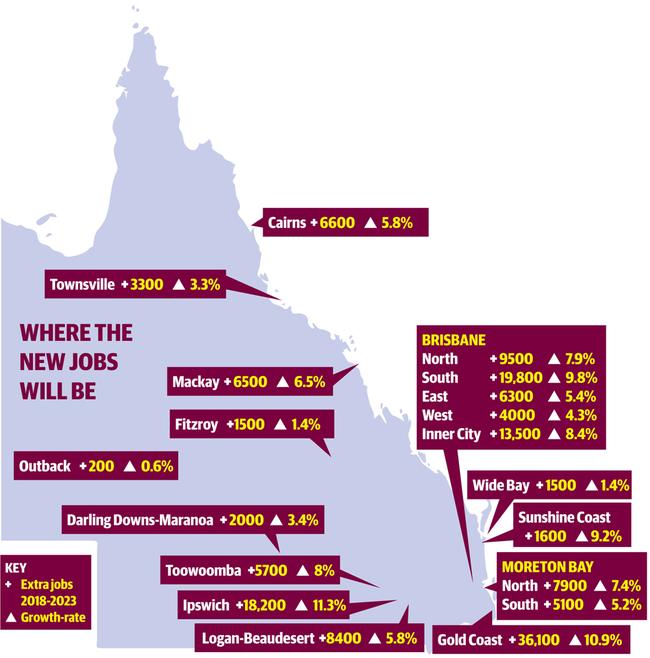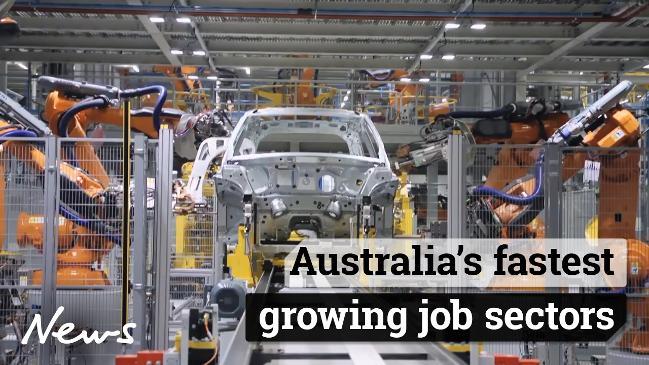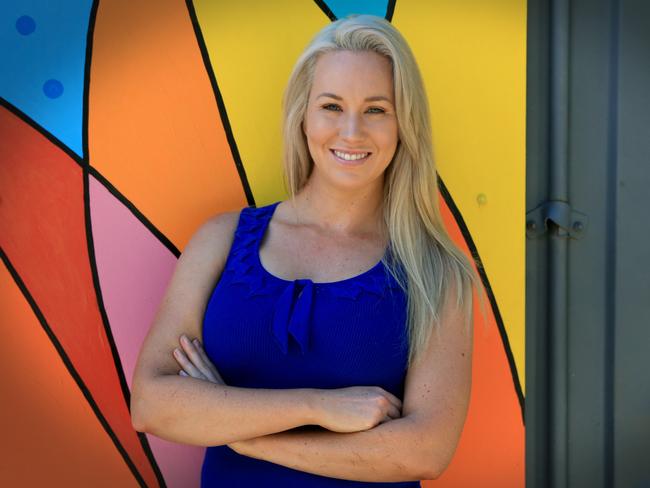New data reveals where the jobs will be in five years
While all the talk has been of robots making roles redundant, official growth projections reveal a massive demand for human skills. Here’s the industries that will boom over the next five years and how you can get on board.

QLD Business
Don't miss out on the headlines from QLD Business. Followed categories will be added to My News.
AUSTRALIA will need an army of new nurses, health and aged-care workers — as well as thousands of waiters and massage therapists — over the next five years.
While all the talk has been of robots making roles redundant, official jobs growth projections reveal a massive demand for human skills.
But secretaries, farmers and bank workers might want to consider a career switch.
Data from the Department of Jobs and Small Business reveals total employment numbers in Australia will rise by 886,100 to May 2023.
Two-thirds of those jobs will be in four sectors: Healthcare and social assistance; construction; education and training; and professional, scientific and technical services.
“When we think about jobs of the future, we tend to think about drone pilots but its nurses, teachers and the like,” social researcher Mark McCrindle said.
The employment market was driven by underlying demographic trends such as ongoing high migration and an older population.
“When you get population growth and factors within that population growth such as an ageing population and policies such as the NDIS (National Disability Insurance Scheme), you get a real boost to related occupations,” he said.

The healthcare and social assistance sector is set to swell by 250,300 jobs. The 14.9 per cent growth rate is more than double the overall 7 per cent. They will include 69,000 aged and disability carers and 51,000 registered nurses.
“Childcare is also on the rise. Both people in a couple working is a big factor there,” Mr McCrindle said.
The construction industry will grow 10 per cent — with 118,800 extra jobs.
“There is demand for over 100,000 new dwellings a year in Australia on top of the knockdown and rebuilds and renovations. Trades are in good shape,” Mr McCrindle said “The retail sector is the biggest employer in Australia in terms of total staff at present but it has limited growth going forward.
“People are going direct to manufacturers so wholesaling is also under a bit of pressure.”
Hospitality will thrive, with nearly 22,000 more waiters needed and 17,000 extra chefs.
Mr McCrindle said the encouragement in recent years for people to study STEM subjects — science, technology, engineering and mathematics — was validated with professional, scientific and technical services roles to rise by 106,600.
“What surprised me is that the fears about automation leading to large-scale job losses that sometimes come up in these big picture reports is not borne out here,” he said.
“Things are not as bad as some suggest. People are not going to lose their jobs in mass numbers tomorrow.
“The effect of automation is a longer-term time frame than many fear. There’s no need to panic. There is time to plan the next phase of your career path. I would look for a job that involves interaction with people. That’s the common thread in this.
“Anything with people skills, thinking skills and which requires human interaction will be in demand.”

Mr McCrindle said the future for working women was bright with big growth in sectors such as health, caring and education which traditionally attracted females.
“It also gives encouragement to older Australians who can feel particularly vulnerable to technological change,” he said. “The future is not all about using computers and apps and new technologies. There are strong options in caring for people.”
Specialist managerial roles would also expand faster.
“A lot of these management roles will require people with more experience and maturity,” he said.
Some employment areas will shrink, however.
“Any jobs that are procedural, repetitive and can be replaced with technology will be vulnerable. Call centres, admin, back office support services are being done away with or outsourced to other countries,” Mr McCrindle said.
The workforce will have to be increasingly flexible going forward. A teenager today will have an average 17 jobs and five separate careers in their working lives.
“The average tenure in a job is currently three years. Half the workforce moves on every three years,” Mr McCrindle said. “I would invest in transferable skills, communication skills, management and leadership skills — human skills.”
Mr McCrindle said it was prudent for young people and their parents to take the projections into account as they planned school and university subjects and career paths.
“Teachers and parents say to kids ‘just follow your passion’. That’s good advice but I would say also look at what jobs are going to be there at the same time. Line up your passion with the reality,” he said.

Australian Industry Group Queensland head Shane Rodgers said the data reflected both the short-term labour demand in the economy, as well as the beginning of some longer-term trends.
“In manufacturing, the skills and occupational profile change reflects the move towards higher-skilled roles in advanced manufacturing as well as the need to revitalise the trade training pipeline to cope with growing demand,” he said. “There is also a healthy trend increase in education, training and child care/early learning positions as growing emphasis is placed on our need to re-skill and keep up with global best practice in all levels of learning.”
Rebecca Groves was one of the lucky ones to get her first preference for her dream job as a nurse at Logan Hospital.
“I want to make a difference in this world so that my son can grow up with amazing opportunities and not have to fight for quality of life,” she said.
Ms Groves said graduate jobs were competitive but well worth the commitment.
“Only a few of my nursing cohort did not get nursing graduate jobs,” she said.
Michael De Vito, who works at Campos Coffee in Brisbane’s Newstead, is planning a career in hospitality.
“It’s a forever evolving industry. It’s articulate and there is so much room for opportunity,” he said.
“It’s better than being stuck in a 9-5 job … there’s a lot more to making coffee.”
Mr De Vito believes hospitality’s fast-paced nature attracts people to the industry.
“It’s a fun industry, and there is always something new,” he said.

AUSTRALIA FACES SKILLS SHORTAGE
AUSTRALIA is facing a serious skills and training shortage as the workforce transforms.
Australian Industry Group research has found there are major skills pressures, as education and training systems fail to keep pace with change.
A national survey revealed companies are increasingly conducting their own training to cover a gap in the vocational education system.
“Already skills shortages are rife,” AI Group Queensland head Shane Rodgers said.
“Research we conducted showed 75 per cent of companies now have skills shortages, most often in the technician and trades worker category.
“Difficulties remain with the recruitment of employees with STEM (science, technology, engineering and maths) skills. For the first time in our survey, shortages were reported for those with skills in business automation, Big Data and artificial intelligence solutions.”

Mr Rodgers said it was disturbing that 99 per cent of employers said they were affected by low levels of literacy and numeracy among workers.
Just over 60 per cent said a lack of leadership and management skills was having a high impact on the business.
Some 52 per cent of firms intend to lift spending on training this year — the highest level since the survey started in 2012 — and a third plan to add apprentices and trainees. More than four in 10 trainees/apprentices are now mature-age.
Looking forward, Mr Rodgers says, industry has to be prepared for a “jobnado” that is already beginning to reshape the employment landscape.
We will need more “mid-air refuelling” of careers, rather than slow-burn qualifications that are likely to be obsolete.
“As automation, robotics, machine learning and computerisation move into realms previously only seen in science fiction, many occupations will undoubtedly be hollowed out or disappear completely,” Mr Rodgers said. “This will overlay a new era of creative and person-to-person service jobs in a world where the mundane is seldom performed by humans.”

GOLD COAST AND IPSWICH TO LEAD
IPSWICH and the Gold Coast will be driving Queensland’s jobs growth over the next five years.
Employment projections show one in three of all new positions created across the state between now and 2023 will be in those two areas. Each will see jobs growth of about 11 per cent — half as fast again as the state as a whole.
The data from the federal Department of Jobs and Small Business projects Ipswich will gain 18,200 jobs, while the Gold Coast will add twice that at 36,100.
Seven of the top 10 growth regions will be outside Brisbane, with the Sunshine Coast, Toowoomba, Moreton Bay, Mackay and Logan-Beaudesert also expected to perform strongly.
Ross Elliott, Queensland general manager for property and infrastructure consultants APP and a director of the Suburban Alliance think-tank and lobby group, said it was a very different picture to the southern states.

Greater Brisbane’s proportion of jobs will remain at just under 51 per cent of the Queensland total, while Melbourne’s share of the Victorian total will soar from 77 to 85 per cent, and Sydney’s slice of NSW’s employment will go from 67 to 76 per cent.
Inner-city Brisbane will have Queensland’s fifth fastest jobs increase, boosted by major developments, but the central city will still account for only one in eight jobs in Brisbane.
“We have to stop this notion that everyone goes to work in the city at 9am each day. It’s a redundant image,” Mr Elliott said.
The employment strength of outer areas was good news for the sustainable growth and liveability of the southeast.
Suburban Alliance is calling for even more to be done to stimulate growth in outer urban areas with strategic investment and development.
It wants to see the urban renewal model which revitalised inner city areas, such as Teneriffe, New Farm, Fortitude Valley and Newstead, applied in a suburban renewal initiative.


